Perseus and Medusa: between Warburg and Benjamin*
Alice Barale
Abstract italiano
English abstract
“Je marchais sur le bord de la mer, je suivais une plage sans fin [...]. L'air, délicieusement rude et pur, pesant sur mon visage et sur mes membres, m'opposait un héros impalpable qu'il fallait vaincre pour avancer. Et cette résistance toujours repoussée fasait de moi-même, à chaque pas, un héros imaginaire, victorieux du vent, et riche de forces toujours renaissantes, toujours égales à la puissance de l'invisible adversaire... C'est là précisément la jeunesse [...]”.
“ [...] Quel amour-propre! Tu oublies que nous sommes ombres...”
(Paul Valéry, Eupalinos)
I.
We know that the ancient Greek hero Perseus plays a fundamental role in Warburg's essay on Schifanoia Palace. It is now during the Kreuzlingen confinement, that Warburg receives the proofs of his Schifanoia article (in 1922), and that Perseus seems to become more and more important in Warburg's meditation. With his fight against the monster Medusa, Perseus is – as Warburg writes in a letter from Kreuzlingen, in 1924 – “the symbol of the world-directed energy (weltzugewandte Energie; WIA, GC, 2-3 February 1924)”. And only a few hours before his death, the last notes Warburg writes are “Perseus or energetic aesthetics as logical orientation in Giordano Bruno” (Warburg 1926-1929, 555).

Francesco del Cossa and workshop, The first decan of Aries, Ferrara, Salone dei Mesi in Palazzo Schifanoia. Pictures. The constellation of Perseus.
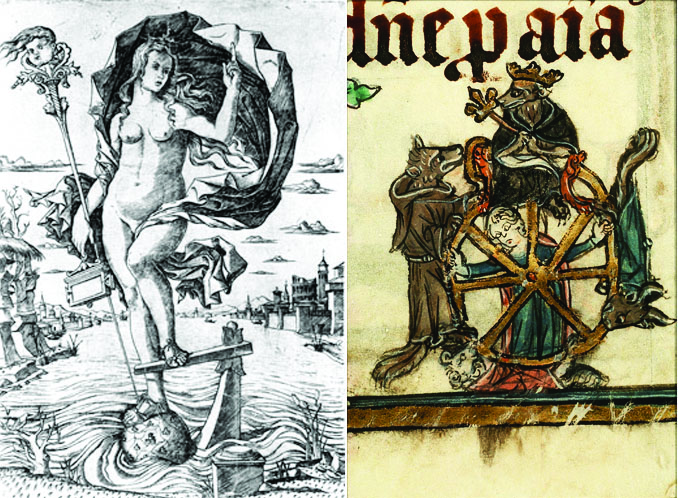
Nicoletto da Modena, Fortuna, ca.1506, Berlin, Staatliche Museen, Kupferstichkabinett
Fortuna with wheel
In the myth of Perseus Warburg sees, coming together, the two main topics of his research: the pathosformula, with the fight against the monster, and the astrological topic, with Perseus' rising to the sky, and becoming a constellation. But what does Perseus exactly represent, or: what does “energetic aesthetics” mean?
In the Sassetti essay (Warburg 1907), the “energy” of the Renaissance man was meant as his capacity of overcoming the Middle Ages' resignation, trying to turn destiny to his favour. A symbol of that was the Fortuna with sail, that replaces the ancient Fortuna with wheel: the new dynamism of the Renaissance tradesman against the fatalism of Middle Ages. Now – as we saw with the editorial staff of Engramma, working on Engramma 92, which is all about Fortuna – Warburg has continued with these meditations on the Fortuna topic until his most mature period.
And it is I think precisely during the Kreuzlingen confinement that a change can be seen. In Kreuzlingen – as we know from the texts of the period, that Claudia Wedepohl has edited together with Davide Stimilli – Warburg starts working on the forces of destiny (Schicksalmaechte: Schicksalmaechte im Spiegel antikisierender Symbolik, Forces of destiny in the mirror of the antiquing Symbology, is the title of the fragments; see Warburg 1924). Now, in these notes an important role is given not so much to Perseus, but rather to the beaten monster Medusa, and to her sisters' wailing, to the Gorgons’ wailing, from which goddess Athena composed the first flute music. This is Pindar (XII Pithic Ode, in Warburg 1924, 45).
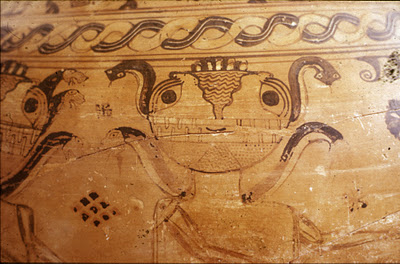
The Gorgons, Eleusis amphora (Proto-Attic), Eleusis Museum
So horror and pain find here their redemption in art. This interpretation of the Medusa myth was adopted many years later in a particular sense by Siegfried Kracauer, in a book whose subtitle is exactly “The Redemption of Physical Reality”: Theory of Film. It was published in 1960, and it shows an evident connection (Marco Bertozzi has worked on that: see Bertozzi 2006, 15-37) with Panofsky's film essay (Style and Medium in the Motion Pictures, whose first version was published in 1937). With his friendship with Panofsky Kracauer was actually successful where Benjamin failed, in the attempt to set a connection between the “Frankfurter Schule” and the Warburg-Kreis. To get back to Medusa, we read in Kracauer's Theory of Film that “Perhaps Perseus' greatest achievement was not to cut off Medusa's head but to overcome his fears and look at its reflection in the shield” (Kracauer 1960, 306). That is to “redeem horror from its invisibility” (ibidem). Recently, Georges Didi-Huberman returned to this point, to claim the necessity and the duty of image “in spite of all” (Didi-Huberman 2003, 220 ss.; see on that “Engramma”, 84).
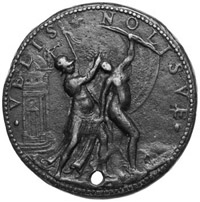
Battista Bonini, Medal for Camillo Agrippa, ca. 1580, London, British Museum
But in Warburg's interpretation of the myth of Perseus this is maybe not exactly – or rather not only – the point. A signal of that is the unexpected sympathy for Medusa, that comes out from the consideration of Perseus' violence. Perseus beheading Medusa corresponds actually, in the works of this period, to the brutality of another hero, the warrior who grabs Fortuna by the hair on this Renaissance medal.
Like with the ancient Occasio, the Greek demon that, as we have seen again with the editorial staff of “Engramma” (see again “Engramma” 92), must be grabbed by the forelock. What this warrior does – Warburg writes in the postscript to Alfred Doren's lecture – is nothing else than “absurd and brutal folly” (Warburg 1923). Because Fortuna, like we can see from its connection with the word “fortunale” (windstorm), can not be caught; except by unfurling the sails, and keeping the hand on the wheel.
Medusa was actually a sea monster. And in a letter of the same period (WIA, GC, 29 January 1924) Perseus is compared to Faust, who tries at the end of the poem to hold back the sea. A Faust who is yet less self-confident and triumphant than the original one, and who, in another letter from Kreuzlingen (ivi, 19 February 1923), is compared in his digging (to hold back the sea) to Hamlet's gravedigger.
It can be interesting that Warburg copies several times, inside a very interesting group of quotes of the same Kreuzlingen period (WIA, III.93.14.2), a letter from Goethe that dates back to a much earlier period, when young Goethe was close to the Sturm und Drang movement. The letter begins with the view of a dangerous sea voyage: “Still tossed on the waves in my little boat, and when the stars go out I just drift along in the hand of fate, and courage and hope, fear and quiescence, alternate in my breast” (Goethe to Herder, July 1772; see again “Engramma” 92). So the protagonists are here the sea, and the waves. The other pole of navigation, and of the myth of Perseus, the stars, appears in another text Warburg copies in the same Kreuzlingen folder, that is Gottfried Keller's Invocation to the Great Bear. We know from the letters of the period that Warburg has been looking for this poem for a long time, and when he finally gets the poem, he copies it, like young Goethe's letter, many times inside his quotations folder. In this poem Keller invokes from his deathbed the constellation of the Great Bear – “Heerwagen, maechtig Stern der Germanen...” – asking it to carry him away, like a child who has neither weight nor fault.
II.
Keller is a constant presence in the letters Warburg writes from Kreuzlingen. He suggests him as a reading to his children, he recalls his novels in relation with his own experiences, and he desperately looks, as we have seen, for his last poem. And Keller is, as we know, much beloved also by Walter Benjamin. Benjamin's most important mention of Medusa, in the Arcades Project, comes from Keller. The end of Baudelaire's poem La destruction (Destruction) – we'll see it later – is described here, with a quotation from Keller, as “the image of the petrified unrest” (J 50,5). The entire expression, that Benjamin quotes straight after, is: “War wie ein Medusenschild/ der erstarrten Unruh Bild (was like a Medusa-shield/ image of petrified unrest)”.
The poem these verses come from (G. Keller, Verlorenes Recht, verlorenes Glück) is again about a star, but a star which is, this time, under the sea. I had a jewel – says here an old seaman, who appears in his traveling over the sea as the “image of the petrified unrest” – that helped me in every navigation, and that jewel was the right (das Recht). But now it's lost, and the star that it was shines in the depth of the sea. So what is lost (verloren) here is, as the title says, the right.
But in his essay on Keller, Benjamin argues that in Keller's writings the real right is actually humor. A kind of humor he describes as a submarine or rather a subterranean movement. Keller's humor is – Benjamin writes in this essay:
"A questionable system of grottoes and caverns that by imperceptible stages tends [...] to constrain and ultimately to repress the rhythmic babble of bourgeois voices and opinions in favour of the cosmic rhythms it captures within the bowels of the earth. If we seek a name for this miracle of grottoes and caves, it can be none other than humor. Keller's gentle and melodious laughter is as much at home in these subterranean vaults than Homer's in the heavenly ones. [...] Keller's humor – Benjamin continues – is not a superficial gilded polish, but the unpredictable ground plan of his half-melancholic, half-choleric nature. [...] In its own way, humor is itself a kind of judicial system. It is the universe of enforcement without verdict, a universe in which both verdict and pardon express themselves through laughter" (Benjamin 1927, 54).
With the image of the earth tremors that Keller’s subterranean humor causes, the energetic topic that Warburg relates to Perseus comes here as well to the fore. These tremors are – Benjamin writes – “enforcement without verdict”. So it is here the definitive nature of verdict that is called off. Because these tremors are at the same time, with Benjamin's words, “verdict and pardon”. Now Baudelaire’s poem La destruction ended abruptly with the image of an uncompleted destruction, which Benjamin argues to be the image of the “petrified unrest”: “Et jette dans mes yeux pleins de confusion / Des vêtements souillés, des blessures ouvertes,/ Et l'appareil sanglant de la Destruction!”. As Benjamin writes in another note of the Arcades Project:
"The bloody implements of destruction (l’appareil sanglant de la destruction), the display of which is thrust upon the poet by the devil” are the implements of allegory: are, with Benjamin’s words again, “allegory's courtyard: the strewn implements with which allegory has so disfigured and mauled the material world that only fragments remain as the object of its contemplation (j 68, 2)”.
The poem itself, Benjamin continues, “breaks off abruptly, creating the impression – doubly surprising for a sonnet – of itself being something fragmentary” (ibidem). Now, this uncompleted destruction Baudelaire’s poem ends with is replaced in Keller's subterranean movements with a kind of destruction that is each time, as we have seen, both accomplished and cured. Until the next earth tremor.
We get closer this way to Benjamin’s second Medusa image. In his first version of the Berliner Kindheit (Berliner Childhood, 1933), which was titled Berliner Chronik (Berliner Chronicle, 1932), Benjamin writes about a ring that portrayed a Medusa's head. Not the Medusa shield anymore then, but the Medusa itself. Her (or its) head.
In her book The Severed Head: Capital Visions, Julia Kristeva has written about Medusa's severed head. The severed head becomes here the symbol of the open wound that affects the visible world. According to Kristeva the faculty of representing originates actually as a reaction to the mother's loss, that the baby experiences as a psychological state. And it is this loss that the severed head – the Medusa's head, but also Holofernes', Saint John the Baptist's, and we can add with Warburg Orfeo's – represents. Kristeva's analysis is close here, for several aspects, to Derrida's. In Derrida's Glas Medusa represents actually, inside the Hegel interpretation, the Other, the original space (the chora), of which image and Aufhebung are only the rest.
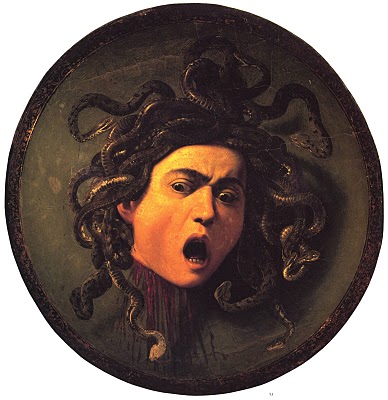
Caravaggio, Medusa, ca. 1597, Florence, Uffizi
But the ring Benjamin writes about in the Berliner Chronicle has not so much to do with a trace or a rest, like the Medusa's severed head, but rather with a vibrant presence, that is with the Medusa's “deep glowing eyes”:
“It was the most fascinating ring I have never seen. Cut in a dark, solid garnet, it portrayed Medusa's head. [...] Worn on the finger, the ring seemed merely the most perfect of signet rings. You entered its secret only taking it off and contemplating the head against the light. As the different strata of the garnet were unequally translucent [...] the somber bodies of the snakes seemed to rise above the two deep, glowing eyes, which looked out from a face that, in the purple-black portions of the cheeks, receded once more into the night” (Benjamin 1932, 616).
Now, Medusa's gaze is one of the main topics of a book by a scholar who will become quite close to Benjamin in his last french period, Roger Caillois. We know how interested, and critical, Benjamin will be towards Caillois, Bataille and the Collège de sociologie (see on that Hollier 1979). Now in Meduse et compagnie, published later, in 1960, Caillois writes about a kind of mimetic behaviour, that produces a motionless, glowing circle, similar to an enormous and hypnotic eye.
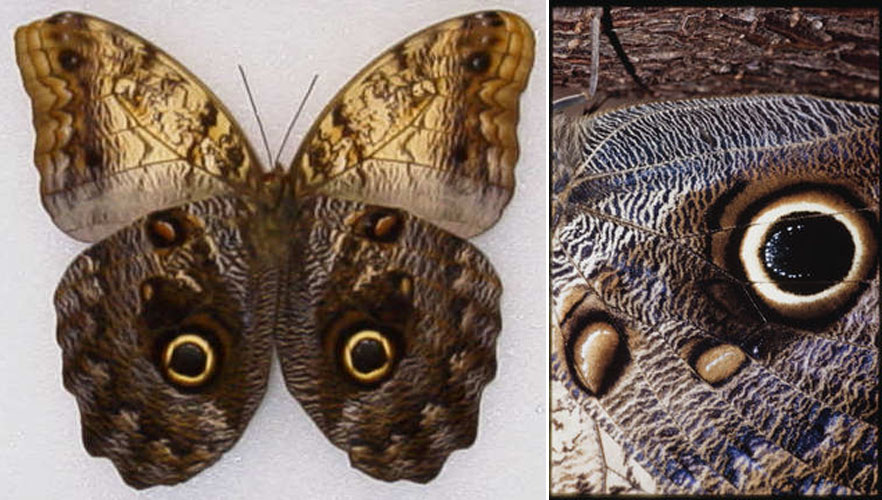
Ocelli: butterfly “Caligo Prometheus”, from Caillois (1960)
It is actually a kind of vertigo that the motionless circle produces. A vertigo that Caillois had already analyzed in Les démons de midi (The Noontide Demons), 1936, and which is basically an identification with the inanimated world. “Verrà la morte e avrà i tuoi occhi” (“Death will come and will have your eyes”), will write a few years later Cesare Pavese. And some more years later, in his essay on Medusa published in 1985, La mort dans les yeux (Death in the Eyes), Jean-Pierre Vernant interprets Medusa's motionless, mask gaze as the gaze of what is absolutely “other”, that is of death with its chaos and its loss of sense – the same loss of sense the ancient heroic death (la belle mort) was trying to remove.
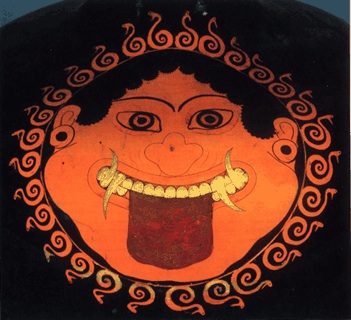
A Gorgoneion: Gorgon's head, ca. 460 B.C.
To get back to Caillois, it is maybe no accident, that only a few years before Les démons du midi an italian scholar, Mario Praz, dedicated to the “Medusean beauty” the first chapter of his book, La carne, la morte e il diavolo nella letteratura romantica (Flesh, Death and the Devil in Romantic Literature), and that this chapter ends actually with Baudelaire.
Actually Benjamin points out that the eyes in Baudelaire's poetry have the same stillness as that of the mythical creatures Caillois is writing about: “Plonge tes yeux dans les yeux fixes/ des Satyresses ou des Nixes” (“Plunge your eyes into the fixed gaze/ Of Satyresses or Nixies”), Benjamin quotes in the Arcades Project from Baudelaire's poem L'advertisseur (The Warner) (J 47 a, I). And also in the second Exposé he writes for the Arcades Project (1939), Benjamin writes that in Baudelaire's poetry “the face of Modernity itself blasts us with an immemorial gaze. Such was the gaze of Medusa for the Greeks” (Benjamin 1939, 23). But against the force of myth another opposite force occurs in Baudelaire's poetry, that is the force of allegory: “It was owing to the genius of allegory – Benjamin writes in the Arcades project – that Baudelaire did not succumb to the abyss of myth that gaped beneath his feet at every step” (J 22, 5). The “petrified unrest” means actually the impossibility, for the allegorical image, of being the image. The image of death, of the abyss. Because for the genius of allegory the abyss has no image, and image is as we have seen just a fragment on the brink of it.
But this is only a step in Benjamin's criticism of myth. The second step concerns more directly the energetic topic, that Warburg connects to the figure of Perseus. It concerns the earth tremors that Keller's humor causes. And it concerns the glowing gaze of the Medusa ring. Which is not, like for Caillois' Medusa, attraction into the abyss, but rather a light that comes out from it.
Opposite to the strength of this light is the ring's fragility. “I tried more than once to stamp a seal with this stone – Benajmin writes – but it proved easy to crack and in need of the utmost care” (Benjamin 1932, 616). It brings to mind the warrior's catch of the Fortuna with sails, that risks – Warburg writes – sinking the ship. And Italo Calvino's Perseus, who – in the Lezioni americane (Six memos for the Next Millennium) – lays down, according to Ovidio, “the snake haired head” on a bed of leaves and weeds, so that “the rough sand should not harm it” (Calvino 1985, 3 ss.; original italian version, 6 ss). Energy appears so to be connected here with fragility. Let's see in what sense.
III.
“Perseus or energetic aesthetics as logical orientation in Giordano Bruno” are, as we have seen, the last notes Warburg writes just before his death. And Aesthetics is actually – as we are going to see in a moment – the topic of the international conference Warburg was going to take part in Hamburg a few months later.
In Bruno's Spaccio della bestia trionfante (The Expulsion of the Triumphant Beast), that Warburg reads a few months before this note, during his last trip to Italy, Perseus is among the astrological gods who must leave their place in heaven, as a consequence of the moral reform of heaven the Olympic gods have undertaken. But Perseus together with a few others keeps his commission to perform it on earth. It is again, Warburg writes, his energy that the world needs.
But again what is this energy? Energy for doing what?
Right after Lo Spaccio Warburg, who is still travelling in Italy, reads Bruno's De gli eroici furori (The Heroic Furies or On Heroic Frenzies). Ad it is here that – as I will try to show – the two moments of the story of Perseus – the one on earth, with the fight with the monster, and the one in heaven, when he becomes a constellation – meet. In his notes about Bruno, Warburg copies a long passage from the Furori, which is about the difficulty the human soul has reaching the gods and divinity from the low seat it has (Warburg 1929, 973). But although he began this trip to investigate the idea of mystical ascent, what Warburg discovers in it is – as we read in the letters of the period – that ascent and descent have to be considered as one.
Let's get back for a moment to the Eroici Furori. The hunter Atteone, who represents here the enterprise of knowledge, runs at the end of the dialogue into Diana, who's here the symbol of nature, and according to the myth is turned into a deer, and eaten by his own dogs. So the hunter becomes the prey, Perseus and Medusa turn out to be one thing. But the Eroici Furori are not a mystical experience, in the true sense of the word. Vertigo and oblivion, that Caillois ascribes to the noontide demons, are not the Heroic Frenzies' conclusion. Bruno writes actually that the frenzies are “not an oblivion but a memory”, not a “bestial rapture”, but a “rational fervour” (Bruno 1585, 43). And Warburg writes about the frenzies that it's the “heroic and erotic devotion to chaos and to Hyle (the material world)”, that produces the “Denkraum (the space of thought)” (Warburg 1929, 979). Ascent and descent so together. Perseus and Medusa, man and animal, thought and material world transform each other. Therein lies the energetic feature of the aesthetic experience Warburg is here analyzing.
In another note of the same period, Warburg writes that “wo die Ethik fort ist und noch keine Philosophie, da kann die Aesthetik Kaffee kochen (When ethic is over and there's still no philosophy, then aesthetics can make coffee)” (Warburg 1926-1929, 126). Now we can understand then the value of this proposal. In a historical period where logic and ethic seem to waver, a few years before Caillois noontide vertigo and Praz corrupted beauty, Warburg indicates the contact with the still formless world of nature and Hyle as the source where a new logic and ethic orientation can and must arise always again. Nature is released then from its demonic appearance, from its evil eye. Demonic is not the world but always, as Benjamin writes at the end of the Origin of the German Tragic Drama, the knowledge of it (Benjamin 1928, 255). The raw mass (“die rohe Masse”: I take the expression from Warburg's notes on Burckhardt, WIA, 113.1.1) knowledge turns to is not demonic in itself, exactly because it is still row, formless. Umbra profunda, in the words of Bruno. Fruitful, still indeterminate force. Whereto we must always return, to brake the shells, as Warburg writes in the Bruno notes, that lock us.
The Congress of Aesthetics Warburg was going to take part to was postponed, as Dorothea McEwan reconstructs in her Wanderstrassen der Kultur (103 ss.). Anyway, Warburg wouldn't have been able to be there, because he died as we have seen a few months before the decided date. But a few years later, at the second international congress of aesthetics that was held in Paris in 1937, Paul Valéry also proposes an energetic idea of aesthetics. Fabrizio Desideri (2009) has considered this aspect of the Discours sur l'éstetique (Discourse on Aesthetics), that Valéry pronounced at the Congress. Sensation is described here as the occasion of a mutual transformation between physical and mental. Sensation is actually, Valéry says, “Etincelle et lumière – Eveil, appel, invasion... (Spark and light – awakening, call, invasion)”.
Spark and awakening. That brings to mind of course Benjamin's thought in The Arcades Project about awakening, and about the dialectical image as “an image flashing up in the now of its recognizability” (N 9, 7). The history continuum then goes to pieces, and past and present “come together in a flesh” (N 2a, 3). It is actually the same energy that smashes in Bruno the “shells” of the ancient cosmos, the “beasts” fixed in the sky.
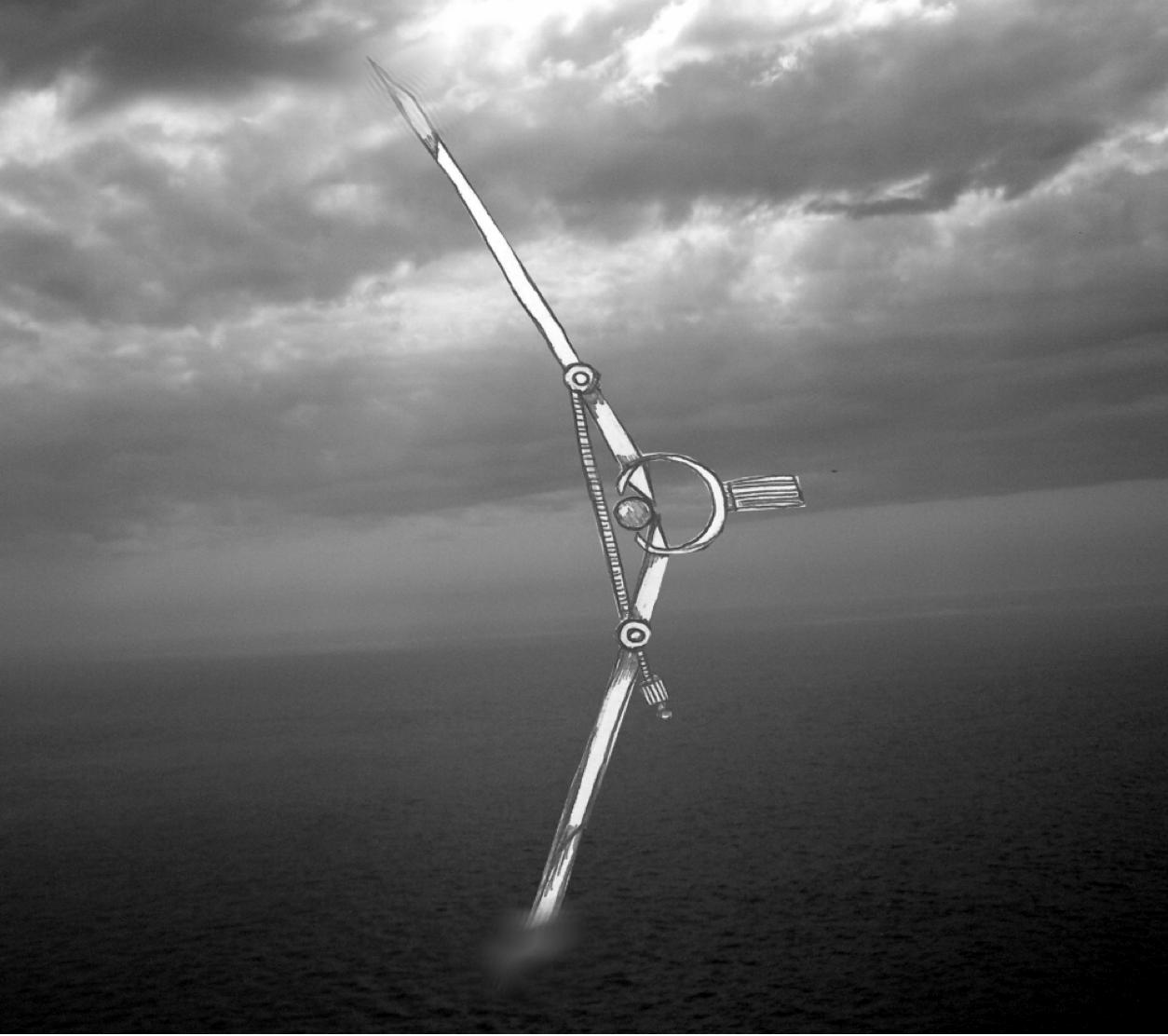
Walter Benjamin, Ex Libris for Valéry, reconstructed
But this energy is not – this is important, and we understand it well from Benjamin's idea of dialectical image – a mere immediacy, an ecstatic rush that leaves the past behind. Benjamin writes in the Arcades Project that “in the dialectical image what has been within a particular epoch is always, simultaneously, what has been from time immemorial” (N 4, 1). And for this reason, that he reveals the newest as the oldest, Adorno writes about Benjamin that his gaze is a Medusa gaze (Adorno 1967). Yet Benjamin writes something else, which is also very important: that “only dialectical images are... not archaic images” (Benjamin 1929-1940: N 3, 1). The antiquity the dialectical image discovers inside modernity is maybe then something different from the fixed appearance of myth Adorno writes about in his Benjamin essay. It is rather that (with Benjamin's words) “kind of authentic and shriveled Antiquity” “Keller's writings are”, with Benjamin's words, “filled with” (Benjamin 1927, 55). And it is the Antiquity that, in one of the most beautiful passages Valéry wrote according to Benjamin, in the Eupalinos (1923), takes the form of the strange object Socrates finds on the shore, a “puzzling” object, with Benjamin's words, “ivory, or marble, or animal bone” (Benjamin 1931, 31). “Une forme à doutes”, Valéry writes. It is ultimately, this Antiquity, the secret core of phenomena. That, which in the encounter with phenomena precedes and exceeds every image and every imagination of them. “To save the phenomena”, according to Benjamin, means then to go back to their secret core, to their “forme à doutes”, to their being fertile. “What distinguishes a truly general phenomenon is its fertility”, Benjamin quotes from Valéry (Benjamin 1929-1940, N 5 a, 6). For this reason maybe the “giant compass” Benjamin imagines as Ex Libris for Valéry, in the tribute essay he composes for Valéry's sixtieth birthday, has one arm “stretched out wide toward the horizon” and the other “firmly anchored in the seabed” (Benjamin 1931, 531).
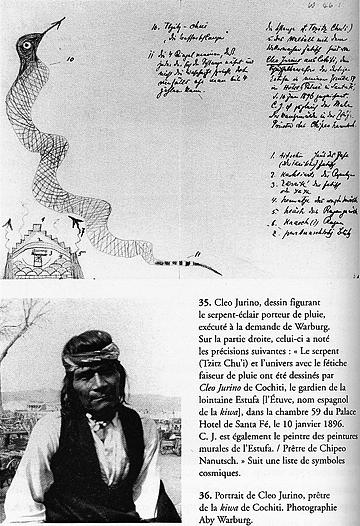
Cleo Jurino, Drawing of serpent and 'worldhouse' with Warburg's annotations
There, where Keller's lost star shines. And where these strange creatures live that Valéry calls “beings of matter beyond compare, translucent and sensitive, flesh of glass, absurdly unstable... long living strings (êtres d'une substance incomparable, translucide et sensible, chairs de verre follement irritables [...], long laniéres vives)” (Valéry 1938). Like Warburg's snakes. And like Medusa's hair that, Calvino teaches, one must handle with care.
* The text is taken from the speech for the Warburg, Benjamin and Kulturwissenschaft conference (London, The Warburg Institute 14-15 June 2012)
Riferimenti bibliografici
- Adorno 1967
T. W. Adorno, A Portrait of Walter Benjamin, in Prisms, Cambridge (MA) [1967] 1983, 227-242. - Benjamin 1927
W. Benjamin, Gottfried Keller, in Selected Writings, vol. II, part. I, Cambridge (MA) [1927] 2005, 51 ss. - Benjamin 1928
W. Benjamin, Ursprung des deutschen Trauerspiels, trad. it. E. Filippini, Turin [1928] 1971. - Benjamin 1929-1940
W. Benjamin, Das Passagen-Werk, en. tr. The Arcades Project, Cambridge (MA) [1929-1940] 1999. - Benjamin 1931
W. Benjamin, Paul Valéry, in Selected Writings, vol. II, part II, Cambridge (MA) [1931] 2005, 531 ss. - Benjamin 1932
W. Benjamin, Berliner Chronicle, in Selected Writings, vol. II, part II, Cambridge (MA) [1932] 2005, 595 ss. - Benjamin 1939
W. Benjamin, Second Exposé, in The Arcades Project, Cambridge (MA) [1939] 1999, 14 ss. - Bertozzi 2006
M. Bertozzi, Il detective melanconico e altri saggi filosofici, Milano [2006] 2008. - Bruno 1584
G. Bruno, Spaccio della bestia trionfante, ed. M. Ciliberto, Milan [1584] 2008. - Bruno 1585
G. Bruno, Gli eroici furori, ed. M. Ciliberto, Rome-Bari, [1585] 2000. - Caillois 1936
R. Callois, Les Démons de midi, It. tr. I demoni meridiani, ed. C. Ossola, Turin [1936] 1988. - Caillois 1960
R. Callois, Méduse et compagnie, It. tr. L'occhio di Medusa, Milan [1969] 1998. - Calvino 1985
I. Calvino, Lezioni americane. Sei proposte per il prossimo millennio, Milan [1985] 1988; En. tr. Six Memos for the Next Millennium, Cambridge (MA) 1988. - Derrida 1974
J. Derrida, Glas, Paris 1974. - Desideri 2009
F. Desideri, Sur la polarité entre “esthésique” et “poïétique” Une analyse du Discours sur l’esthétique de Valéry, “Recherches valéryennes”, 20, 2009, 9-42. - Didi-Huberman 2003
G. Didi-Huberman, Images malgré tout, Paris 2003. - Hollier 1979
F. Hollier, Le collège de sociologie, Paris 1979. - Kracauer 1960
S. Kracauer, Theory of Film. The Redemption of Physical Reality, Princeton 1997. - Kristeva 1998
J. Kristeva, Vision Capitales, en. tr. The Severed Head: Capital Visions, New York 2012; trad it. La testa senza il corpo, Rome 2009. - McEwan 2004
D. McEwan, 'Wanderstrassen der Kultur'. Die Aby Warburg - Fritz Saxl Korrespondenz von 1920 bis 1929, Munich 2004. - Panofsky 1947
E. Panofsky, Style and Medium in the Motion Pictures, “Critique” 1.3 (January-February 1947), 5-28. - Praz 1930
M. Pratz, La carne, la morte e il diavolo nella letteratura romantica, Milano 2008. - Valéry 1921
P. Valéry, Eupalinos, in Oeuvres, vol. II, Paris 1960, 79-147. - Valéry 1937
P. Valéry, Discours sur l'esthétique, in Oeuvres, vol. I, Paris 1960, 1294-1314. - Valéry 1938
P. Valéry, Degas, Danse, Dessin, Paris 1998. - Vernant 1985
J.-P. Vernant, La mort dans les yeux. Figures de l'autre en Grèce ancienne, trad. it. La morte negli occhi. Figure dell'altro nell'antica Grecia, Bologna 1987. - Warburg WIA
A. Warburg, Warburg Institute Archive, London. - Warburg 1907
A. Warburg, Francesco Sassettis letzwillige Verfügung, trad. it. M. Ghelardi, in A. Warburg, Opere, vol. I, Turin 2004, 425-484. - Warburg 1922
A. Warburg, Italienische Kunst und internationale Astrologie im Palazzo Schifanoia zu Ferrara, in L'Italia e l'Arte straniera. Atti del X Congresso Internazionale di Storia dell'Arte, 1912, Rome 1922; trad. it. in Opere, vol. I, Turin 2004, 515-555. - Warburg 1923
A. Warburg, Nachtrag zu Alfred Dorens Vortrag “Fortuna im Mittelalter und in der Renaissance”, in “Per monstra ad sphaeram”. Vortrag in Gedenken an Franz Boll und andere Schriften 1923 bis 1925, eds D. Stimilli and C. Wedepohl, Munich [1923] 2008. - Warburg 1924
A. Warburg, Schicksalmächte im Spiegel antikisierender Symbolik, in D. Stimilli, C. Wedepohl (a cura di), “Per monstra ad sphaeram”. Vortrag in Gedenken an Franz Boll und andere Schriften 1923 bis 1925, eds D. Stimilli and C. Wedepohl, Munich [1924] 2008. - Warburg 1926-1929
A. Warburg, Tagebebuch der Kulturwissenschaftlichen Bibliothek Warburg, Berlin [1926-1929] 2001. - Warburg 1929
A. Warburg, Giordano Bruno, appunti, WIA III, 121.1.1; trad. it. M. Ghelardi, in A. Warburg, Opere, vol. 2, Turin [1929] 2008, 920-993.
Abstract
Già al centro, come è noto, del saggio warburghiano su Palazzo Schifanoia, la figura di Perseo sembra diventare sempre più importante nel periodo del ricovero a Kreuzlingen. E ancora l'ultima annotazione che Warburg lascia poche ora prima di morire recita: “Perseo o estetica energetica come orientamento logico in Giordano Bruno”. Ma cosa rappresenta esattamente Perseo, ovvero, cos'è l'estetica energetica?
English abstract
Perseus was the focus of the warburgian essay on Palazzo Schifanoia and his figure seems to become more and more important to Warburg during the Kreuzlingen confinement. In his last note Warburg wrote “Perseus or energetic aesthetics as logical orientation in Giordano Bruno”. But what does Perseus exactly represent, or: what does “energetic aesthetics” mean?
keywords | Perseus; Warburg; Energetic Aestetics; Kreuzlingen period.
Per citare questo articolo / To cite this article: A. Barale, Perseus and Medusa: between Warburg and Benjamin, “La Rivista di Engramma” n. 105, aprile 2013, pp. 89-101 | PDF